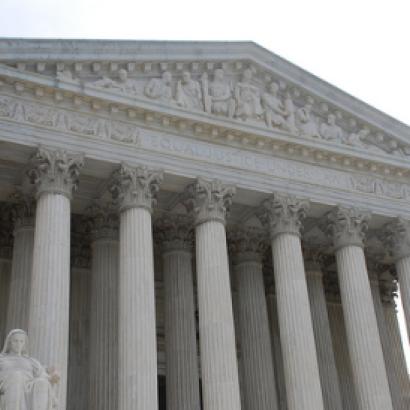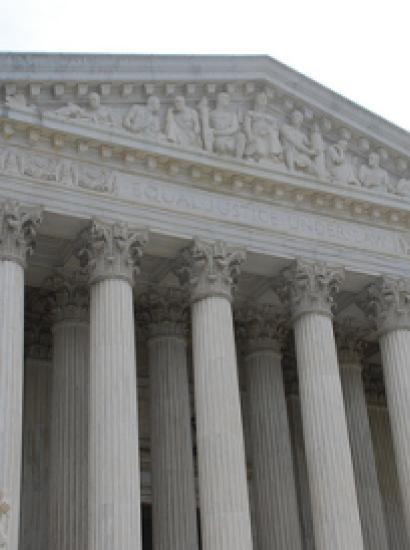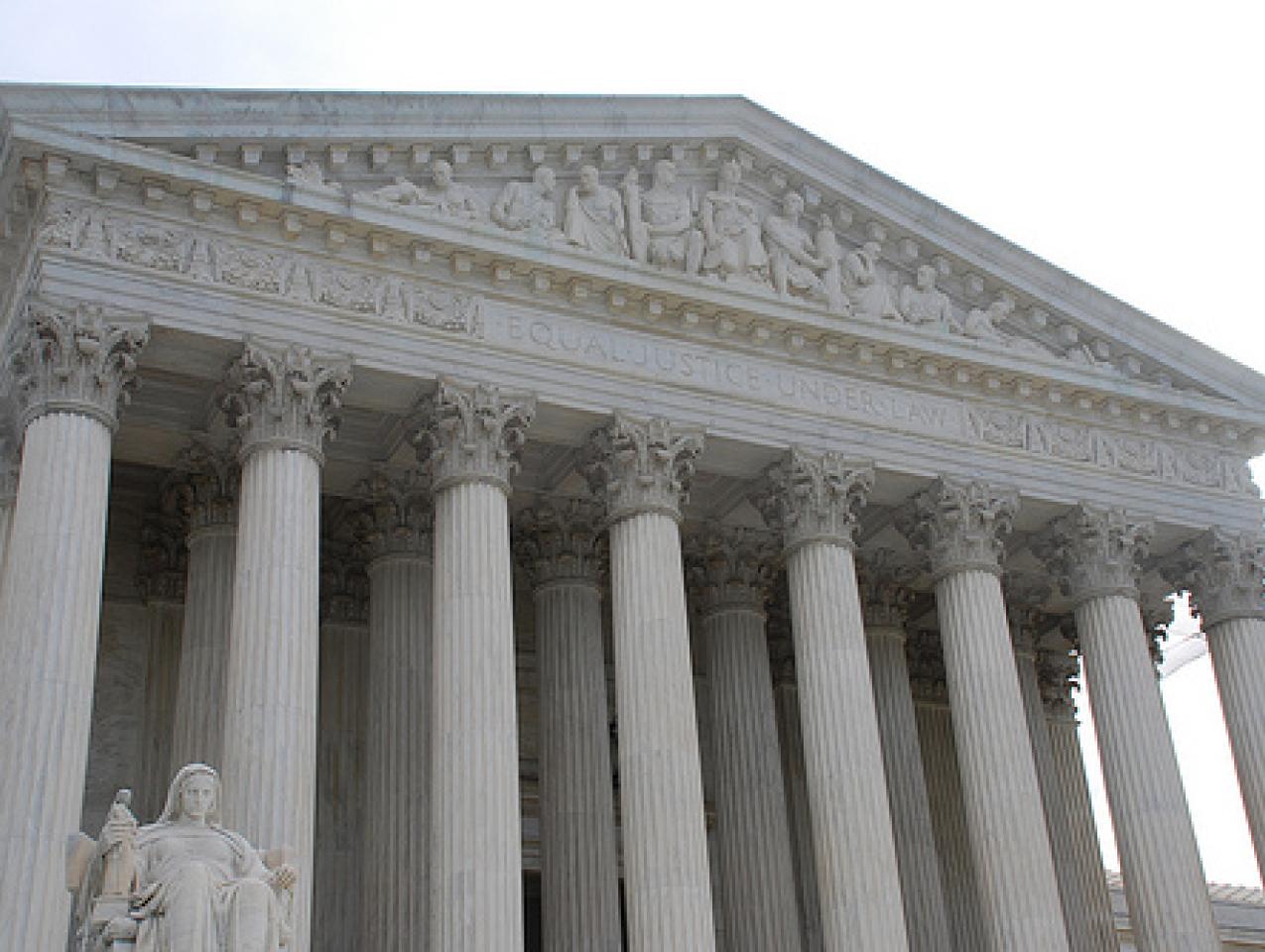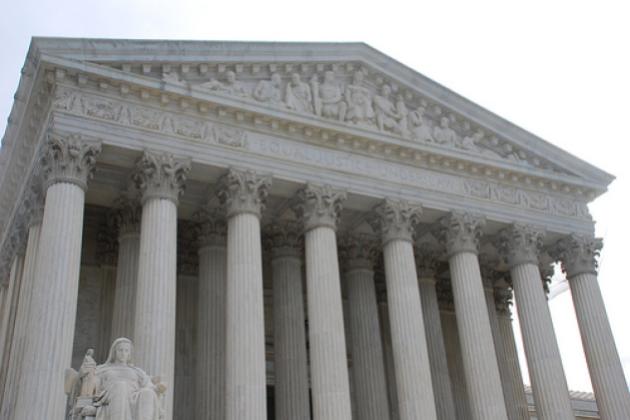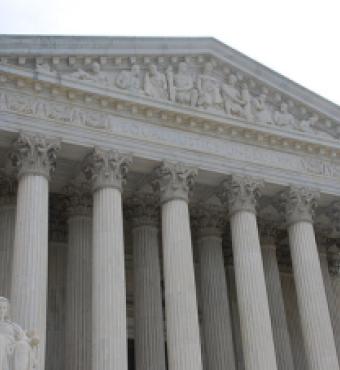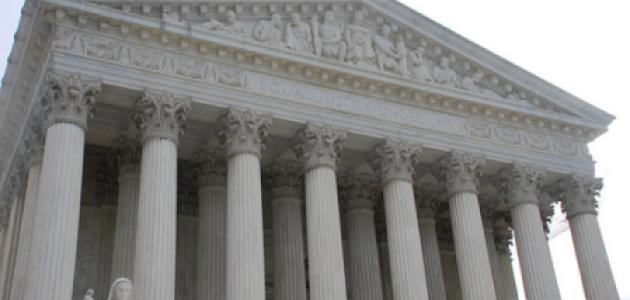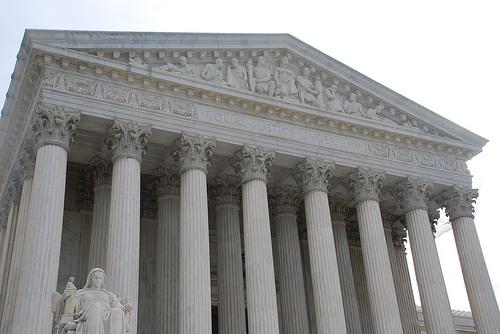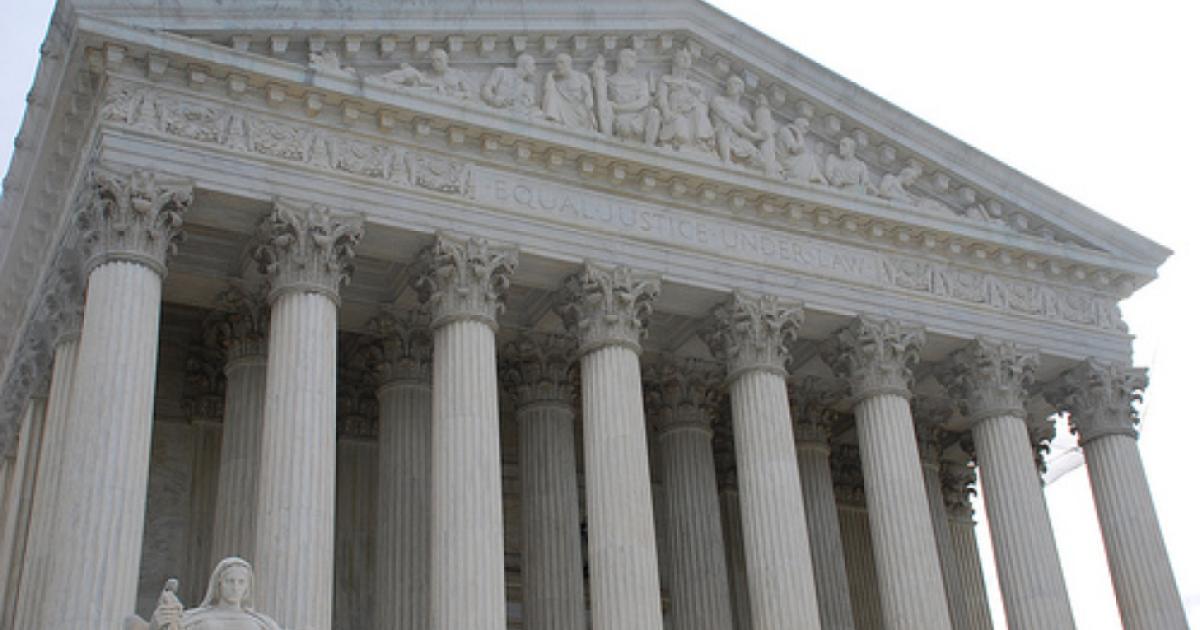- Law & Policy
- Regulation & Property Rights
For many years the Supreme Court has been intervening in patent cases, including three patent cases in the Court’s present term. That should trouble anyone interested in improving innovation, competition, jobs, and economic growth.
These cases are converting our patent system from one that fosters innovation and competition into one that frustrates both. This is surprising because in some other commercial areas of law like antitrust, the Court has over the past several years generally tacked in a direction that favors markets.
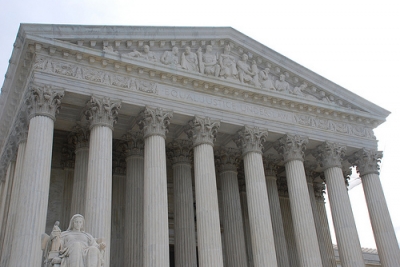
Photo Credit: deltaMike
These cases are making it harder for patents to serve their socially beneficial role in helping bring new technologies to market by facilitating coordination among inventors, investors, managers, laborers, distributors, and the like, so they can form new business ventures. Instead these cases are helping big companies collude with each other while tying up market entrants in endless process.
What may be even more troubling is that all of this harm is coming without any sound justification because these cases don’t involve the types of questions the Court should even touch. In almost every one, the Court has focused entirely on the inner-workings of our patent system. Although the Court should intervene when it thinks the political branches of government have acted beyond their power or in a way that unduly impinges somebody’s Constitutional Right, the Court should stay out of questions that are so high-level they should be left to the political branches of government or so down in the weeds they should be left to the experts.
This year’s big Supreme Court patent case is Microsoft v. i4i. The patent in question covers a system for editing codes in computer documents that use the XML markup language. The plaintiff, i4i, is a company that sells add-on software that enables the Microsoft Word program to edit XML. The case arose when Microsoft built that functionality into its latest version of Word, leaving future users with no reason to buy the add-on.
The main issue of the case is a debate about burdens of proof. Microsoft has been charged with violating a patent. It wants to defend itself by attacking the validity of the patent rather than relying on a non-infringement defense. The somewhat heavy burden of proof the law has long placed on a party alleging a patent's invalidity is known as "clear and convincing evidence." The lighter burden known as "the preponderance of the evidence" is used for other issues in commercial law, including the presence or absence of patent infringement. Microsoft is asking the Court to extend the lighter burden to invalidity challenges as well. Although the slight differences between these burdens of proof may seem to be too minor to matter, they turn out to reveal how the patent process has run amok in a costly way.
BACKGROUND ON THE CASE
The gist of Microsoft’s argument is that our patent system is overflowing with so many junk patents that smaller players, like i4i, need only to threaten big players like Microsoft with countless meritless, but expensive-to-defend-litigations in order to shake those big players down for settlements or scare them out of core business lines. The problem with that argument is that it doesn’t fit the facts of the case.
After a full trial with the usual arguments covering the range of issues typical to a complex patent case with large stakes and well-financed parties on both sides, the jury awarded over $200 million to i4i in regular damages, deciding that its patent was not invalid and that Microsoft infringed the patent willfully.
The judge then entered an injunction and enhanced the damages by $40 million to account for the willfulness. The appellate court stayed the injunction pending the appeal, but ultimately affirmed the entire case including the injunction, enhanced damages, regular damages, and findings of willfulness, infringement, and no invalidity.
Along the way, Microsoft convinced the Patent Office to conduct one full reexamination of the i4i patent, but to no avail because the office reaffirmed the validity of the same original patent claims. The office also refused to grant a second reexamination because Microsoft was unable to show any substantial new question of patentability.
Microsoft has been charged with violating a patent and it wants to defend itself by attacking the validity of the patent.
Now the case is before the Supreme Court, where Microsoft’s argument has strong surface appeal to both political flanks of the Court. Some left-leaning justices, who are likely skeptical of property rights in general, may also be skeptical of patents. Some right-leaning justices, who may be skeptical of government action in general, may be moved by examples of silly patents and the oft-repeated statistic that Patent Office examiners spend only about eighteen hours reviewing each patent application.
And while former Supreme Court clerks of all political stripes rarely have a hard time finding good jobs, experience with patent cases only makes it easier to hit the ground running in this particularly vibrant area of practice. Besides, everyone at the Court may simply view a chance to see a recent area of technological advance as a fun break from the ongoing Battle Royale over big social issues.
It just turns out each of these surface concerns makes no sense upon reflection. Those on the left should remember that prominent populist jurists like Jerome Frank were champions of the push to strengthen patents when the 1952 Patent Act was passed to implement our present patent statutes. They also should remember that one of the major domestic policy initiatives during the end of the Carter Administration was the push to again strengthen patents with the creation of the US Court of Appeals for the Federal Circuit. Those on the right should remember that silly patents are the epitome of red herrings and that patents can be well functioning property rights not clumsy regulatory entitlements.
If patent critics who fear silly patents envision the infamous one on a method of exercising a cat by shining a dot of light on a wall, then we should all realize that nobody’s making enough money in that business to even attract the attention of a shake down artist like the infamous patent trolling plaintiff firms that are so often decried in policy debates about patents. If critics of silly patents envision those that claim things like perpetual motion, they should remember that nobody infringes such a patent because it doesn’t work. And if by silly they mean nobody will even try to use the invention then nobody will spend money to bring or defend a lawsuit over it.
PROBLEMS WITH THE PATENT PROCESS
That is not to say there is no legitimate concern that Microsoft could be raising about patents. Maybe patent critics are really worried about a different aspect of patents. In the real world of imperfections, delays, transaction costs, and other frictions, one real problem with any legal system is they way its costs and delays can really stack up.
Maybe the concern about junk patents is motivated by a fear that for too many patents the examiners just don’t do a good job examining the application and the prior art. That concern is then magnified by the rule that gives all patents a presumption of validity when issued by the Patent Office. This is a problem that requires some heavy detailed analysis and that may be why it’s so hard to deploy as a one-line-zinger at the start of a petition for Supreme Court review or in the headline of an op-ed.
To be valid, a patent is supposed to be new and non-obvious over the prior art, and be well described in the originally filed application. Maybe the concern about junk patents is motivated by a fear that for too many patents, the examiners just don’t do a good job examining the application and the prior art. That concern is then magnified by the rule that gives all patents a presumption of validity when issued by the Patent Office.
Under that presumption, a party who wants to challenge a patent’s validity in court must carry a heavier burden than is typical for commercial litigation. Most issues in commercial litigation must be proven by a preponderance of the evidence, which basically means that the jury has to think the probability of the contested fact is greater than 50 percent. But in patent litigation, allegations of invalidity have to be proven by clear and convincing evidence, which is a slightly heavier burden, although far lighter than the criminal law burden of beyond a reasonable doubt. The core issue the Supreme Court is addressing in Microsoft v. i4i is whether to keep that standard at the clear and convincing level or to dial it down to the preponderance standard.
All decision-making processes make errors. Some get to yes when they should have gotten to no and some get to no when they should have gotten to yes. The system we have brings with it the risk of some cases like the Microsoft v. i4i where the best attacks on the patent end up not succeeding. But on what basis should this patent have been held invalid?
Today’s patent system is reminiscent of the bleak one described by Charles Dickens in "A Poor Man’s Tale of a Patent," which left patentees "quite wore out, patience and pocket."
Microsoft is right that this case is an example of process run amok. But it is arguments and tactics like those being used by Microsoft that cause the dizzying array of process. For arguments about the prior art, for example, all that the party like Microsoft who wants to challenge a patent has to do to meet the clear and convincing burden would be to bring into court a single publication that is earlier than the patent’s priority date and that shows all of the elements of the claimed invention. It would also kill the patent to show that all elements of the invention are shown by a combination of two or more documents if it also can be shown that the prior art provides some reason these particular prior art references would have been combined. And there are many more ways to invalidate a patent, which is why for decades about half of the litigated patents are found to be invalid.
The patent in this case was pitched over the plate at one of the strongest, fastest, keenest sluggers in the major leagues. Microsoft had a full trial with all the witnesses, documents, and other evidence of prior art that it could muster under the Federal Rules of Evidence and Civil Procedure. It also got a full appeal. It even got two cracks at a return to the Patent Office for reexamination. And Microsoft struck out every time, fair and square.
This case proves is that it is not about patents that would be tossed out if someone spent the money needed to prove them invalid. To the contrary, this case shows that the high costs of litigation and other legal proceedings about which patent critics complain actually cut both ways. Having already lost so many times on the facts, Microsoft seems to just want more process and argument. There are serious risks to exposing every patent to such unending hand waving.
A system that simply dials down the presumption of validity is likely to be worse than our present one. It would leave patentees facing an unending set of procedural hurdles, each one potentially infinitely high, but none affording real protection to the patentee if she is lucky enough to jump over it.
Patents cost a great deal to get. The $15,000-$30,000 in out of pocket cash it typically takes to go through the Patent office is the ante. The application, which is published soon after filing, must teach the world how to practice the invention. The enormous cost of disclosing trade secrets is a big reason companies like Google have long avoided filing for patents on components of their core technologies.
Then comes the long delay, with most patent office examination procedures taking at least three years, and some easily twice that long. If the Patent Office decides to issue a patent, it can be buffeted by repeated requests for reexamination, as happened to i4i. Enforcing the patent in court then takes several million dollars and another three to five years to litigate through trial, and additional millions and dollars and countless years as the case goes up on appeal, and as happens to about half of the appeals, the case may get remanded for another several years and several million dollars worth of new trial.
When patents only last twenty years from the time the application was filed, the entire clock can easily run out before a court-imposed remedy, like damages and an injunction, is ordered, let alone executed. And that assumes the remedies are available.
In its 2006 eBay decision, the Supreme Court encouraged lower courts to be more hesitant about issuing injunctions in patent cases. And when the US Court of Appeals for the Federal Circuit decided to grant a rehearing before the full court in the case of TiVo v. EchoStar, it also became harder to enforce any injunction a patentee does get. The Court of Appeals’ 2007 decision in the Seagate case made it much harder for patentees to get damages enhanced in cases where the infringement was willful. This recent tide of anti-patent court cases is a big reason why the judge in Microsoft v. i4i only enhanced the jury’s $200 million award of regular damages by $40 million to account for the willfulness. An egregious case of willful infringement used to involve a doubling or tripling of the underlying jury award. This practice deterred willful infringers from investing in litigation counsel instead of in designing around the patent or striking a deal with the patentee.
A patent that costs a lot to get from the Patent Office, and a lot more to defend in unending reexamination, but that gives no advantage in court, is a patent that doesn’t do much good to anyone looking to challenge a market leading company. Instead of providing the vital slingshot a David could use to compete with a Goliath as was envisioned by those who crafted the last legislative overhaul of our patent system in 1952, today’s patent system has become remarkably reminiscent of the bleak system vividly described by Charles Dickens in "A Poor Man’s Tale of a Patent," which left patentees "quite wore out, patience and pocket."
Microsoft should not have brought this case to the Supreme Court. Still, the presumption of validity should not be a sacred cow for patentees.
Some check is needed on the procedures used to challenge patents. That’s why it makes sense to require a substantial new question of patentability ("SNQ") before a reexamination process can be launched. That’s also why it makes sense to only let the SNQ threshold be triggered if it is based on published prior art documents.
In the Microsoft v. i4i case, the most recent of the supposed SNQs is an alleged prior sale by the patentee of something embodying the patented invention. The contrasting policy rationales that even allow an inventor’s own prior sale of the invention to count as prior art against her own patent require very particular facts to be proven.
On the one hand, society wants to allow patentees to engage in non-commercial experimentation including field-testing and customer feedback, which is why the Supreme Court’s 1878 City of Elizabeth Paving case allowed the inventor’s prior use of a public road surface to not count as prior art. On the other hand, society does not want to let patentees surreptitiously extend the patent term for long periods. Thus, the Court’s 1881 decision in Egbert v. Lippmann treated it as public use in the prior art when the patentee gave corset steels to an acquaintance for use inside her own undergarments for an extended period of time before filing the patent application.
Factual questions about whether a particular transfer was of the completed invention or merely for testing it involves the type of ordinary documents and witness cross examinations that lay juries are especially good at figuring out. That’s why these issues should go to trial rather than to an administrative office of technological experts, as in reexamination. Because the last prior art leg on which Microsoft now claims it can stand is a purported prior public use or sale of the patentee’s own claimed invention, it makes sense for Microsoft’s second request for reexamination to have been rightly denied.
A FAIR REFORM
While Microsoft should not have brought this case to the Supreme Court, the presumption of validity should not be a sacred cow for patentees. Now that it is stuck before the Court, i4i should follow judo’s wisdom and use the Court’s heavy-handed intervention into the patent system as a way to prop the system back up. It should remind the Court that almost all of the debates about patents really turn on problems relating to abuse of process—and these problems are fundamentally symmetrical, facing both patentees like i4i and infringers like Microsoft.
Dispute resolution processes, like civil court litigation, should pay attention to a set of goals including speed, cost, accuracy, and finality. But these conflicting goals have already been carefully balanced over the many years it took to develop the rules governing the fairest process that we have to offer—our civil litigation system in Federal Court. These rules provide procedures known as joinder, compulsory counterclaims, issue preclusion (also called collateral estoppel), and claim preclusion (also called res judicata), which are collectively designed to avoid an abusive and repetitive process. There are also rules for procedures, such as summary judgment, which are designed to avoid long trials in which there is no genuine issue of material fact.
If we think these rules still allow too many bad arguments to be used to hurl abusive legal procedures on those who oppose us in the marketplace then we might simply return to another well-developed tool: a rule under which a bad loser pays the costs of the winner. Implementing this in our present patent system would be easy. We could return to the rule before the 2007 Seagate decision that gave patentees easier access to attorneys’ fees and enhanced damages when the infringer is on notice of the patent and has no good reason for thinking it is invalid or not infringed.
At the same time we could dial down the presumption of validity to give alleged infringers easier access to the same enhanced damages when the patentee is on notice of the key prior art without a good reason for thinking the patent is still valid over that prior art. Such symmetry in cost and fee shifting would encourage parties to exchange information and resolve disputes before getting deeply into expensive litigation. This pair of changes would directly address the complaints of patent critics without injecting burdensome process, unpredictability, and political manipulability into the system.
The worst way to move forward would be to dial down the presumption of validity alone. That approach would make patents very useful for protecting large established players in the market from new entrants, thereby decreasing both innovation and competition and decreasing economic growth overall.
The best approach may be to dial down the presumption of validity and restore a system of fee shifting for bad losers on either side. Having decided to intervene in this case, it would be easy for the Supreme Court to implement that approach, and both Microsoft and i4i should embrace it if they really have the courage of their convictions – a solid argument about the facts of their respective cases.








